News
-
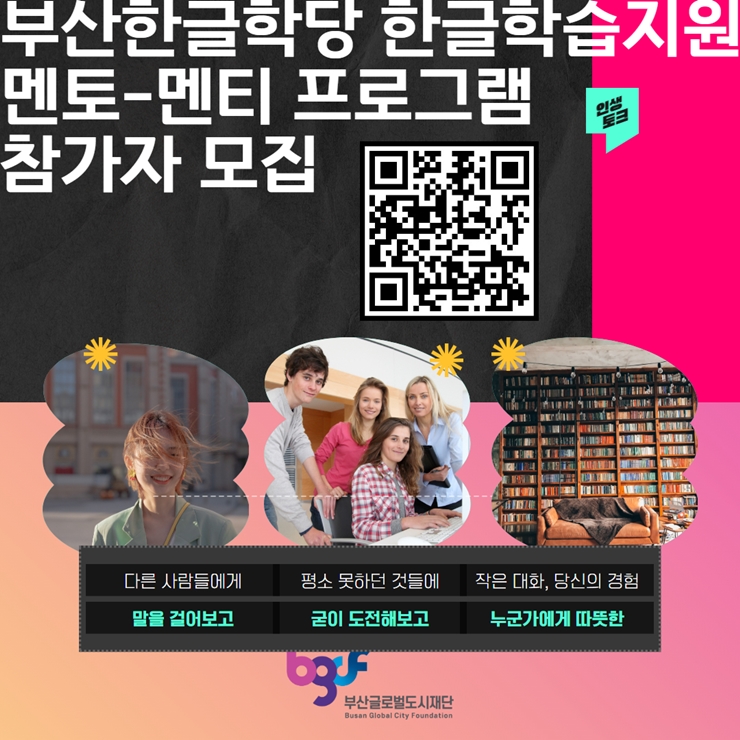.jpg&fileext=jpg&filetype=image/jpeg&filesize=366360) Join the Busan Hangeul School mentorship Program!
Busan Hangeul School is looking for participants for its Hangul (Korean Alphabet) Learning Support Mentor-Mentee Program!▶ When: Oct 27 (Mon) to Nov 21 (Fri), 4 weeks▶ Who: (Mentees) International students living in Busan / (Mentors) Busan residents▶ What: Personalized Hangul learning support for mentees▶ Perks: Mentors receive 10,000 KRW after submitting one activity report▶ Apply by: Oct 16 (Thu)ㅁ★Apply Now : https://m.site.naver.com/1H5Bz
Join the Busan Hangeul School mentorship Program!
Busan Hangeul School is looking for participants for its Hangul (Korean Alphabet) Learning Support Mentor-Mentee Program!▶ When: Oct 27 (Mon) to Nov 21 (Fri), 4 weeks▶ Who: (Mentees) International students living in Busan / (Mentors) Busan residents▶ What: Personalized Hangul learning support for mentees▶ Perks: Mentors receive 10,000 KRW after submitting one activity report▶ Apply by: Oct 16 (Thu)ㅁ★Apply Now : https://m.site.naver.com/1H5Bz
-
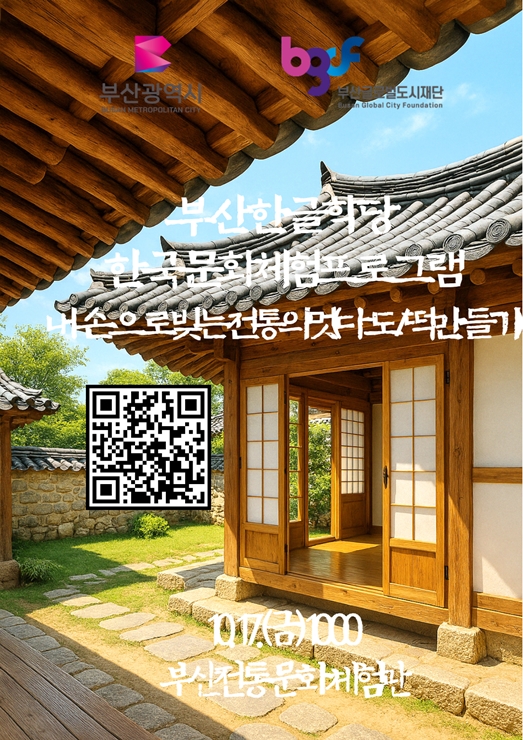 Enjoy Korean culture at Busan Hangeul School!
The Busan Global City Foundation is a public organization that operates various programs and exchange activities to help foreign residents in Busan adapt to local life and build a stable living environment.░ Busan Hangeul School – Korean Cultural Experience Program (Session 3)☑ Date & Time: Friday, October 17, 2025, 10:00 AM – 12:00 PM (2 hours)☑ Venue: Busan Traditional Culture Experience Center(71, Kkotmaeul-ro 163beon-gil, Seo-gu, Busan)☑ Participants: 40 international students residing in Busan☑ Program: Korean tea ceremony experience (learning traditional etiquette) / rice cake making / cultural talk & tasting☑ Participation Fee: Free of charge☑ Application Period: First-come, first-served★Apply Now : https://forms.gle/9W6psK7gt8bs7BoMA ░ Busan Hangeul School – Korean Cultural Experience Program (Session 4)☑ Date & Time: Saturday, October 25, 2025, 9:00 AM – 6:00 PM (9 hours)☑ Meeting Point: Busan Station☑ Participants: 40 international students residing in Busan☑ Program: Busan Highlight Tour (Songdo Marine Cable Car / Haedong Yonggungsa Temple / Gijang Gongsu Fishing Village / Yacht Experience)☑ Participation Fee: 15,000 KRW per person☑ Application Period: First-come, first-served★Apply Now : https://forms.gle/4QiRnYxvVpMSMj587
Enjoy Korean culture at Busan Hangeul School!
The Busan Global City Foundation is a public organization that operates various programs and exchange activities to help foreign residents in Busan adapt to local life and build a stable living environment.░ Busan Hangeul School – Korean Cultural Experience Program (Session 3)☑ Date & Time: Friday, October 17, 2025, 10:00 AM – 12:00 PM (2 hours)☑ Venue: Busan Traditional Culture Experience Center(71, Kkotmaeul-ro 163beon-gil, Seo-gu, Busan)☑ Participants: 40 international students residing in Busan☑ Program: Korean tea ceremony experience (learning traditional etiquette) / rice cake making / cultural talk & tasting☑ Participation Fee: Free of charge☑ Application Period: First-come, first-served★Apply Now : https://forms.gle/9W6psK7gt8bs7BoMA ░ Busan Hangeul School – Korean Cultural Experience Program (Session 4)☑ Date & Time: Saturday, October 25, 2025, 9:00 AM – 6:00 PM (9 hours)☑ Meeting Point: Busan Station☑ Participants: 40 international students residing in Busan☑ Program: Busan Highlight Tour (Songdo Marine Cable Car / Haedong Yonggungsa Temple / Gijang Gongsu Fishing Village / Yacht Experience)☑ Participation Fee: 15,000 KRW per person☑ Application Period: First-come, first-served★Apply Now : https://forms.gle/4QiRnYxvVpMSMj587
-
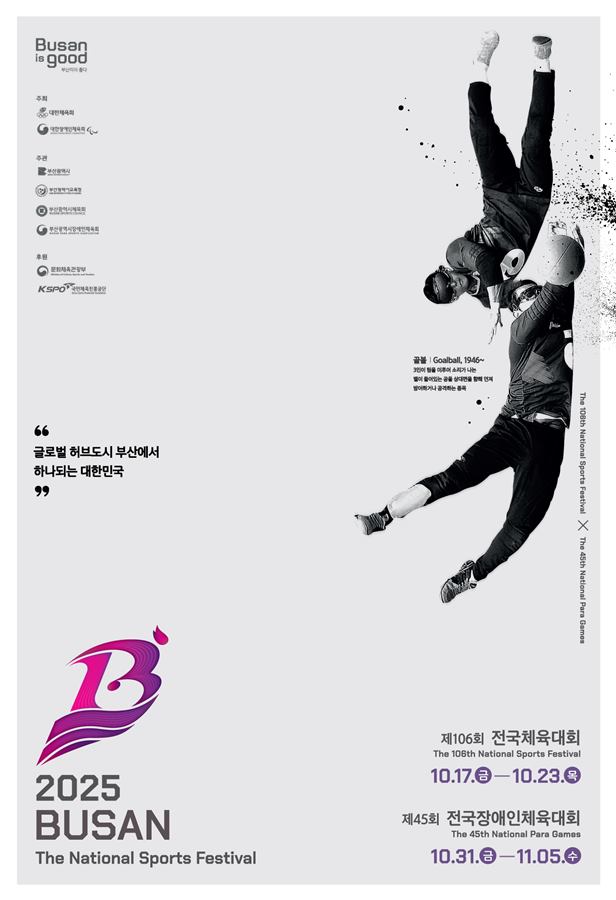 Busan to host the nation's biggest sports festival
In October, Busan will be filled with the fierce and heart-pumping spirit of competition as it hosts the 106th National Sports Festival and the 45th National Para Games. It has been 25 years since Busan last hosted the National Sports Festival, and the event’s return to the city will see a record number of participants.According to the Korean Sport & Olympic Committee, the festival will welcome 28,791 participants from 17 metropolitan cities and provinces nationwide, including 19,418 athletes (12,354 men and 7,064 women) and 9,373 officials.Additionally, Korean sports organizations operating overseas will send a 1,515-member delegation comprising athletes and officials from 18 countries. With more than 4,200 volunteers on board, Busan has prepared extensively to ensure smooth operations, reflecting both the city’s commitment and its citizens’ passion for this significant event. Athletes will compete in 48 events, with an additional two events, foot volleyball and jiu-jitsu, featured as demonstration sports. Each event will include four categories: under-18, university, overseas Koreans and general.Following the National Sports Festival, the 45th National Para Games will take place from Oct. 31 to Nov. 5, featuring 31 sports across 38 venues throughout the city.<Today's Vocabulary - 오늘의 단어>fierce: 맹렬한 delegation: 대표단 athlete: 운동선수 extensively: 광범위하게 venue: 장소Editor: Song SoomiCopy Editors: Ryu Hyoseung, Anton J. Mapoy
Busan to host the nation's biggest sports festival
In October, Busan will be filled with the fierce and heart-pumping spirit of competition as it hosts the 106th National Sports Festival and the 45th National Para Games. It has been 25 years since Busan last hosted the National Sports Festival, and the event’s return to the city will see a record number of participants.According to the Korean Sport & Olympic Committee, the festival will welcome 28,791 participants from 17 metropolitan cities and provinces nationwide, including 19,418 athletes (12,354 men and 7,064 women) and 9,373 officials.Additionally, Korean sports organizations operating overseas will send a 1,515-member delegation comprising athletes and officials from 18 countries. With more than 4,200 volunteers on board, Busan has prepared extensively to ensure smooth operations, reflecting both the city’s commitment and its citizens’ passion for this significant event. Athletes will compete in 48 events, with an additional two events, foot volleyball and jiu-jitsu, featured as demonstration sports. Each event will include four categories: under-18, university, overseas Koreans and general.Following the National Sports Festival, the 45th National Para Games will take place from Oct. 31 to Nov. 5, featuring 31 sports across 38 venues throughout the city.<Today's Vocabulary - 오늘의 단어>fierce: 맹렬한 delegation: 대표단 athlete: 운동선수 extensively: 광범위하게 venue: 장소Editor: Song SoomiCopy Editors: Ryu Hyoseung, Anton J. Mapoy
Enjoy Busan
-
 Busan Port meets Jazz
source: visitbusanNovember is the perfect month to soak up live jazz against the nostalgic backdrop of Busan Port. Every Saturday at 6 p.m., a series of jazz concerts will take place at Space One Z, a spacious warehouse-turned-café in Yeongdo-gu District. The concert will spotlight local musicians dedicated to promoting jazz's cultural and artistic significance. With a lineup of iconic and beloved jazz standards, the musicians invite audiences to experience the multiple, sophisticated layers of rich sound that beautifully complement the nighttime landscape of Busan Port.Admission to the concert is free, though reservations are required and can be made via the Naver Map website linked below. Why not enjoy a romantic Saturday evening and create an unforgettable late-autumn moment that, much like the spontaneous charm of jazz, will never be repeated?※ Busan Jazz Port◎ Space One Z: 214 Bongnaenaru-ro, Yeongdo-gu◎ Schedule: Every Saturday in November, 6 p.m.◎ Admission: Free◎ Reservations: Click<Today's Vocabulary - 오늘의 단어>spacious: 넓은 warehouse: 창고 significance: 중요성 sophisticated: 정교한Editor: Song SoomiCopy Editors: Ryu Hyoseung, Anton J. Mapoy
Busan Port meets Jazz
source: visitbusanNovember is the perfect month to soak up live jazz against the nostalgic backdrop of Busan Port. Every Saturday at 6 p.m., a series of jazz concerts will take place at Space One Z, a spacious warehouse-turned-café in Yeongdo-gu District. The concert will spotlight local musicians dedicated to promoting jazz's cultural and artistic significance. With a lineup of iconic and beloved jazz standards, the musicians invite audiences to experience the multiple, sophisticated layers of rich sound that beautifully complement the nighttime landscape of Busan Port.Admission to the concert is free, though reservations are required and can be made via the Naver Map website linked below. Why not enjoy a romantic Saturday evening and create an unforgettable late-autumn moment that, much like the spontaneous charm of jazz, will never be repeated?※ Busan Jazz Port◎ Space One Z: 214 Bongnaenaru-ro, Yeongdo-gu◎ Schedule: Every Saturday in November, 6 p.m.◎ Admission: Free◎ Reservations: Click<Today's Vocabulary - 오늘의 단어>spacious: 넓은 warehouse: 창고 significance: 중요성 sophisticated: 정교한Editor: Song SoomiCopy Editors: Ryu Hyoseung, Anton J. Mapoy
-
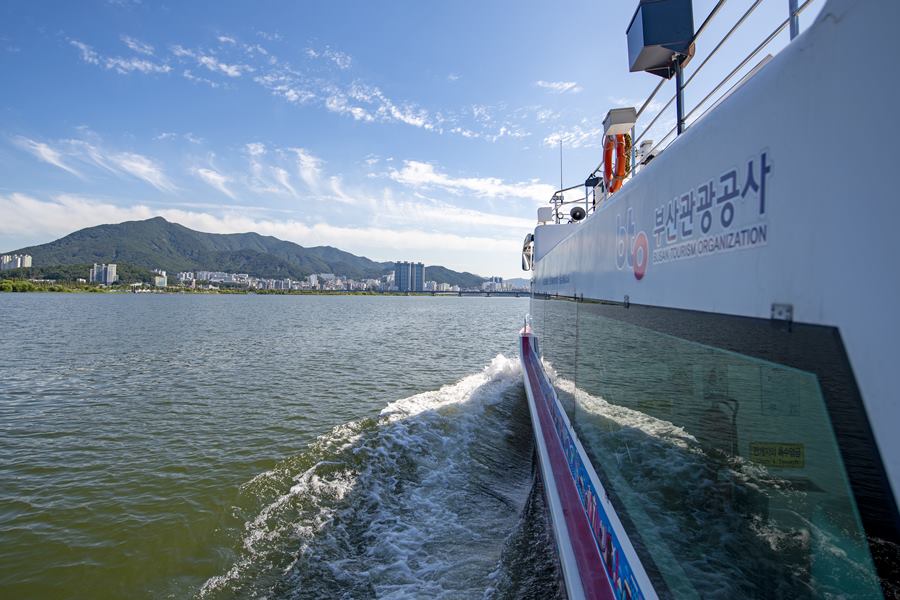 Experience Busan’s golden hour for free on the Nakdonggang River Sunset Tour
source: visitbusanThe Nakdonggang River Ecological Tour Boat is launching a brand-new Sunset Tour along its Hwamyeong route. To celebrate, the city is offering free rides from Nov. 5 to 16 during a two-week pilot program.As the name suggests, the Sunset Tour invites passengers to soak in the breathtaking evening glow over the Nakdonggang River. The 40-minute journey departs from Hwamyeong Dock at 5 p.m., taking over the final daily slot of the existing Hwamyeong line. Along the way, guests can enjoy serene views of Daedong–Hwamyeong Bridge, Gupo Bridge and the river’s natural beauty.Passengers are encouraged to share photos or stories of their river experience on social media for a chance to receive a small souvenir.Following the pilot period, the regular Sunset Tour will begin on Nov. 19 and continue through March 2026. Tickets cost 7,000 won for adults and 5,000 won for minors.Reservations are required and can be made by calling the Eulsukdo Office at 051-294-2131 or 2135.※ Nakdonggang River Ecological Tour Boat: Sunset Tour◎ Free rides: Nov. 5 to 16◎ Departures: 5 p.m. from Hwamyeong Dock, Thursday to Sunday◎ Reservations: 051-294-2131 or 2135.<Today's Vocabulary - 오늘의 단어>launch: 출시하다 soak: 흠뻑 빠지다 souvenir: 기념품 reservation: 예약Editor: Song SoomiCopy Editors: Ryu Hyoseung, Anton J. Mapoy
Experience Busan’s golden hour for free on the Nakdonggang River Sunset Tour
source: visitbusanThe Nakdonggang River Ecological Tour Boat is launching a brand-new Sunset Tour along its Hwamyeong route. To celebrate, the city is offering free rides from Nov. 5 to 16 during a two-week pilot program.As the name suggests, the Sunset Tour invites passengers to soak in the breathtaking evening glow over the Nakdonggang River. The 40-minute journey departs from Hwamyeong Dock at 5 p.m., taking over the final daily slot of the existing Hwamyeong line. Along the way, guests can enjoy serene views of Daedong–Hwamyeong Bridge, Gupo Bridge and the river’s natural beauty.Passengers are encouraged to share photos or stories of their river experience on social media for a chance to receive a small souvenir.Following the pilot period, the regular Sunset Tour will begin on Nov. 19 and continue through March 2026. Tickets cost 7,000 won for adults and 5,000 won for minors.Reservations are required and can be made by calling the Eulsukdo Office at 051-294-2131 or 2135.※ Nakdonggang River Ecological Tour Boat: Sunset Tour◎ Free rides: Nov. 5 to 16◎ Departures: 5 p.m. from Hwamyeong Dock, Thursday to Sunday◎ Reservations: 051-294-2131 or 2135.<Today's Vocabulary - 오늘의 단어>launch: 출시하다 soak: 흠뻑 빠지다 souvenir: 기념품 reservation: 예약Editor: Song SoomiCopy Editors: Ryu Hyoseung, Anton J. Mapoy
-
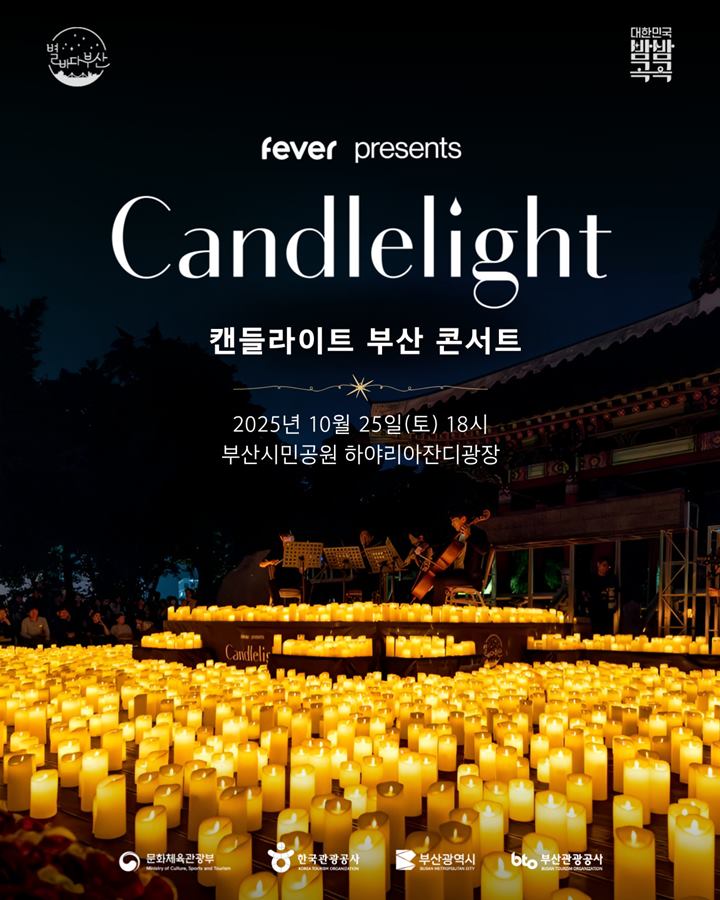.jpg&fileext=jpg&filetype=image/jpeg&filesize=99043) Free Candlelight Busan Concert brings warmth on a cool evening
source: visitbusanOn Oct. 25, people of all ages are invited to spend a cozy night out with the Candlelight Busan Concert. Experience an evening of beautiful melodies while picnicking in the cool autumn air at Hialeah Lawn Plaza at Busan Citizens Park – completely free of charge!The popular Candlelight concert series draws audiences worldwide with its unique mix of spectacular venues, romantic atmosphere and curated selection of classical music.Taking center stage is Risus Quartet, a rising string group that made headlines as the first Korean ensemble to win the grand prize at the Fischoff National Chamber Music Competition (2021 – USA). They’ll be performing fan-favorite pieces by Joe Hisaishi and Kwang-seok Kim, making it a must-see event for classical music fans and anyone who loves emotional film scores and iconic Korean melodies.The performance runs for about 65 minutes, and seating is first-come, first-served. Since it’s an outdoor lawn event, guests should bring their own mats and blankets. Camping chairs and tables with legs are strictly prohibited to protect the park grounds.The event will be filmed and photographed, so by attending, you’re agreeing to possibly being on camera.For updates or additional details, check out the Visit Busan website or follow Starry Night Busan on Instagram.※ Candlelight Busan Concert, 6 p.m. on Oct. 25 ◎ Busan Citizens Park: 73 Simingongwon-ro, Busanjin-gu◎ Website: Click◎ Instagram: @starry_night_busan.kr, @starry_night_busan.en <Today's Vocabulary - 오늘의 단어>draw: 끌어 모으다 audience: 관객 atmosphere: 분위기 lawn: 잔디 Editor: Song SoomiCopy Editors: Ryu Hyoseung, Anton J. Mapoy
Free Candlelight Busan Concert brings warmth on a cool evening
source: visitbusanOn Oct. 25, people of all ages are invited to spend a cozy night out with the Candlelight Busan Concert. Experience an evening of beautiful melodies while picnicking in the cool autumn air at Hialeah Lawn Plaza at Busan Citizens Park – completely free of charge!The popular Candlelight concert series draws audiences worldwide with its unique mix of spectacular venues, romantic atmosphere and curated selection of classical music.Taking center stage is Risus Quartet, a rising string group that made headlines as the first Korean ensemble to win the grand prize at the Fischoff National Chamber Music Competition (2021 – USA). They’ll be performing fan-favorite pieces by Joe Hisaishi and Kwang-seok Kim, making it a must-see event for classical music fans and anyone who loves emotional film scores and iconic Korean melodies.The performance runs for about 65 minutes, and seating is first-come, first-served. Since it’s an outdoor lawn event, guests should bring their own mats and blankets. Camping chairs and tables with legs are strictly prohibited to protect the park grounds.The event will be filmed and photographed, so by attending, you’re agreeing to possibly being on camera.For updates or additional details, check out the Visit Busan website or follow Starry Night Busan on Instagram.※ Candlelight Busan Concert, 6 p.m. on Oct. 25 ◎ Busan Citizens Park: 73 Simingongwon-ro, Busanjin-gu◎ Website: Click◎ Instagram: @starry_night_busan.kr, @starry_night_busan.en <Today's Vocabulary - 오늘의 단어>draw: 끌어 모으다 audience: 관객 atmosphere: 분위기 lawn: 잔디 Editor: Song SoomiCopy Editors: Ryu Hyoseung, Anton J. Mapoy
Food
-
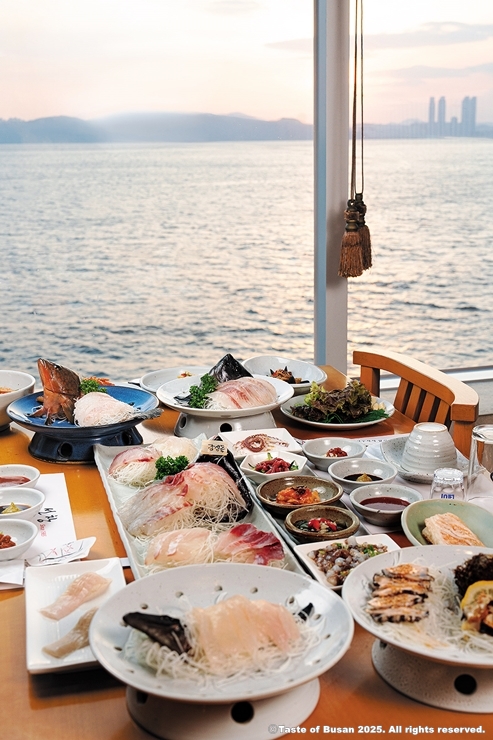 Eat your way through Busan
Food lovers, take note: Busan is a city that rewards curiosity. From bustling seafood markets to stylish bistros, the city offers an abundance of dining options. Across the city, diners will find hundreds of officially designated "Taste of Busan" establishments that promise high-quality meals at fair prices. At the higher end, Busan's culinary reputation is on the rise. The city's Michelin Guide features three one-star restaurants along with numerous Bib Gourmand and Selected listings, proof that Busan is a must-visit for gourmands. Busan offers so much more than fried chicken, barbecue and kimchi. Whether alone, with a date or with a mate, the city is best experienced with an open mind, an empty stomach and loose pants.■Taste of Busan 2025(click to download the guidebook)Enjoy fresh sashimi at Seonchang Hoetjip. Generous portions and toppings are standard at Lee Jaemo Pizza.Gamasot has been serving pork ribs for 30 years. ■Michelin Guide restaurant in Busan(Click to learn more)Palate(one-star)Fiotto(one-star and Green Star)Mori(one-star)
Eat your way through Busan
Food lovers, take note: Busan is a city that rewards curiosity. From bustling seafood markets to stylish bistros, the city offers an abundance of dining options. Across the city, diners will find hundreds of officially designated "Taste of Busan" establishments that promise high-quality meals at fair prices. At the higher end, Busan's culinary reputation is on the rise. The city's Michelin Guide features three one-star restaurants along with numerous Bib Gourmand and Selected listings, proof that Busan is a must-visit for gourmands. Busan offers so much more than fried chicken, barbecue and kimchi. Whether alone, with a date or with a mate, the city is best experienced with an open mind, an empty stomach and loose pants.■Taste of Busan 2025(click to download the guidebook)Enjoy fresh sashimi at Seonchang Hoetjip. Generous portions and toppings are standard at Lee Jaemo Pizza.Gamasot has been serving pork ribs for 30 years. ■Michelin Guide restaurant in Busan(Click to learn more)Palate(one-star)Fiotto(one-star and Green Star)Mori(one-star)
-
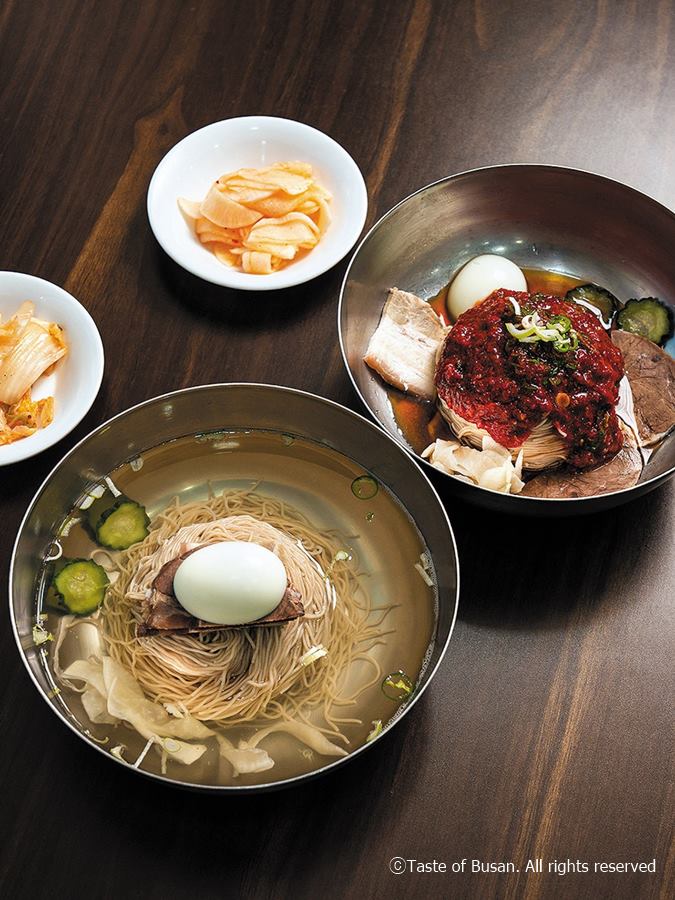 Bite Into Busan ③ Noodles
source: Taste of Busan"Bite Into Busan" is a monthly celebration of the city's restaurants. Each featured spot is listed in the Michelin Guide and Taste of Busan, the city's official gourmet guidebook, and is known for its signature dishes. This month, we take a long look at noodles. Across East Asia, they have evolved from humble, post-war staples to icons of cultural identity. Whether it's icy Korean naengmyeon, savory Japanese ramen or nourishing Taiwanese beef noodle soup, these dishes remind us how strands of dough can carry stories across borders and bring people together, one bowl at a time.🍜 Buda Myeonoak 부다면옥This Pyongyang naengmyeon specialty spot is known for its clean, refreshing flavors. Korean beef shank and fresh vegetables are boiled separately, then cooled the traditional way to create a deeply flavorful broth.*Address: 2F, 36 Jungdong1-ro, Haeundae-gu*Hours: Open 11 a.m. to 8 p.m. Last order at 7:30 p.m. Closed on Mondays.*Menu: Naengmyeon ₩12,000🍜 100.1.Pyeongnaeng 백일평냉True to the craft of traditional cold noodle makers, this restaurant serves authentic Pyongyang naengmyeon with beef broth, salt, and 80% buckwheat noodles. The menu also features homemade North Korean dumpling soup and bulgogi.*Address: 1F, 29 Namcheonbada-ro 10beon-gil, Suyeong-gu*Hours: Open daily, 11:30 a.m. to 3:30 p.m. for lunch and 5:30 to 9 p.m. for dinner. Last order at 8 p.m.*Menu: Pyongyang/Bibim naengmyeon ₩13,000*Available: Takeout🍜 Bao Haus 바오하우스A casual spot serving Taiwanese comfort food with a twist. Try their bao and signature beef noodle soup, both served with quick and friendly service. This popular eatery is housed in a compact space, so waiting times can be long without a reservation.*Address: 62-9 Seojeon-ro 38beon-gil, Busanjin-gu*Hours: Open daily from 11:30 a.m. to 9 p.m. Breaktime from 3 to 5 p.m. No breaktime on weekends.*Menu: Beef noodle soup ₩12,500*Available: Parking, takeout, foreign language menus🍜 Nagahama Mangetsu 나가하마 만게츠Located in the buzzy Haeridan-gil neighborhood, this "ramenya" is the first Korean branch of a popular ramen shop from Fukuoka, Japan. The restaurant's signature Nagahama Ramen draws long lines of diners, who covet the rich, milky, savory broth and thin noodles. *Address: 1F, Daeyeong Building, 57 Udong 1-ro, Haeundae-gu*Hours: Open daily from 11 a.m. to 3:30 p.m. for lunch and 4:30 to 8:30 p.m. for dinner. Last order is 30 minutes before closing. Closed on public holidays.*Menu: Nagahama Ramen ₩11,000<Today's Vocabulary - 오늘의 단어>humble: 검소한 flavorful: 풍미 있는 broth: 육수 buzzy: 활기 넘치는Editor: Song SoomiCopy Editors: Ryu Hyoseung, Anton J. Mapoy
Bite Into Busan ③ Noodles
source: Taste of Busan"Bite Into Busan" is a monthly celebration of the city's restaurants. Each featured spot is listed in the Michelin Guide and Taste of Busan, the city's official gourmet guidebook, and is known for its signature dishes. This month, we take a long look at noodles. Across East Asia, they have evolved from humble, post-war staples to icons of cultural identity. Whether it's icy Korean naengmyeon, savory Japanese ramen or nourishing Taiwanese beef noodle soup, these dishes remind us how strands of dough can carry stories across borders and bring people together, one bowl at a time.🍜 Buda Myeonoak 부다면옥This Pyongyang naengmyeon specialty spot is known for its clean, refreshing flavors. Korean beef shank and fresh vegetables are boiled separately, then cooled the traditional way to create a deeply flavorful broth.*Address: 2F, 36 Jungdong1-ro, Haeundae-gu*Hours: Open 11 a.m. to 8 p.m. Last order at 7:30 p.m. Closed on Mondays.*Menu: Naengmyeon ₩12,000🍜 100.1.Pyeongnaeng 백일평냉True to the craft of traditional cold noodle makers, this restaurant serves authentic Pyongyang naengmyeon with beef broth, salt, and 80% buckwheat noodles. The menu also features homemade North Korean dumpling soup and bulgogi.*Address: 1F, 29 Namcheonbada-ro 10beon-gil, Suyeong-gu*Hours: Open daily, 11:30 a.m. to 3:30 p.m. for lunch and 5:30 to 9 p.m. for dinner. Last order at 8 p.m.*Menu: Pyongyang/Bibim naengmyeon ₩13,000*Available: Takeout🍜 Bao Haus 바오하우스A casual spot serving Taiwanese comfort food with a twist. Try their bao and signature beef noodle soup, both served with quick and friendly service. This popular eatery is housed in a compact space, so waiting times can be long without a reservation.*Address: 62-9 Seojeon-ro 38beon-gil, Busanjin-gu*Hours: Open daily from 11:30 a.m. to 9 p.m. Breaktime from 3 to 5 p.m. No breaktime on weekends.*Menu: Beef noodle soup ₩12,500*Available: Parking, takeout, foreign language menus🍜 Nagahama Mangetsu 나가하마 만게츠Located in the buzzy Haeridan-gil neighborhood, this "ramenya" is the first Korean branch of a popular ramen shop from Fukuoka, Japan. The restaurant's signature Nagahama Ramen draws long lines of diners, who covet the rich, milky, savory broth and thin noodles. *Address: 1F, Daeyeong Building, 57 Udong 1-ro, Haeundae-gu*Hours: Open daily from 11 a.m. to 3:30 p.m. for lunch and 4:30 to 8:30 p.m. for dinner. Last order is 30 minutes before closing. Closed on public holidays.*Menu: Nagahama Ramen ₩11,000<Today's Vocabulary - 오늘의 단어>humble: 검소한 flavorful: 풍미 있는 broth: 육수 buzzy: 활기 넘치는Editor: Song SoomiCopy Editors: Ryu Hyoseung, Anton J. Mapoy
-
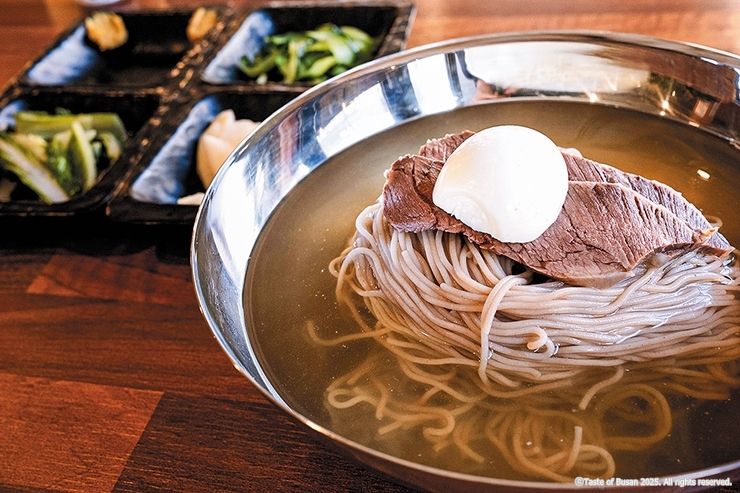 Long strands of tradition
"Bite Into Busan" is a monthly celebration of the city's restaurants. Each featured spot is listed in the Michelin Guide and Taste of Busan, the city's official gourmet guidebook, and is known for its signature dishes. This month, we take a long look at noodles. Across East Asia, they have evolved from humble, post-war staples to icons of cultural identity. Whether it's icy Korean naengmyeon, savory Japanese ramen or nourishing Taiwanese beef noodle soup, these dishes remind us how strands of dough can carry stories across borders and bring people together, one bowl at a time.A bowl of naengmyeon at Buda Myeonoak.■Buda Myeonoak 부다면옥 This Pyongyang naengmyeon specialty spot is known for its clean, refreshing flavors. Korean beef shank and fresh vegetables are boiled separately, then cooled the traditional way to create a deeply flavorful broth.*Address: 2F, 36 Jungdong1-ro, Haeundae-gu*Hours: Open 11 a.m. to 8 p.m. Last order at 7:30 p.m. Closed on Mondays.*Menu: Naengmyeon ₩12,000*Google Map: ClickChoose between naengmyeon in cold broth or sweet and spicy bibim naengmyeon at 100.1.Pyeongnaeng.■100.1.Pyeongnaeng 백일평냉 True to the craft of traditional cold noodle makers, this restaurant serves authentic Pyongyang naengmyeon with beef broth, salt, and 80% buckwheat noodles. The menu also features homemade North Korean dumpling soup and bulgogi.*Address: 1F, 29 Namcheonbada-ro 10beon-gil, Suyeong-gu*Hours: Open daily, 11:30 a.m. to 3:30 p.m. for lunch and 5:30 to 9 p.m. for dinner. Last order at 8 p.m.*Menu: Pyongyang/Bibim naengmyeon ₩13,000*Available: Takeout*Google Map: ClickThe beef noodle soup at Bao Haus.Dan dan noodles at Bao Haus.■Bao Haus 바오하우스 A casual spot serving Taiwanese comfort food with a twist. Try their bao and signature beef noodle soup, both served with quick and friendly service. This popular eatery is housed in a compact space, so waiting times can be long without a reservation.*Address: 62-9 Seojeon-ro 38beon-gil, Busanjin-gu*Hours: Open daily from 11:30 a.m. to 9 p.m. Breaktime from 3 to 5 p.m. No breaktime on weekends.*Menu: Beef noodle soup ₩12,500*Available: Parking, takeout, foreign language menus*Google Map: ClickTonkotsu ramen at Nagahama Mangetsu.■Nagahama Mangetsu 나가하마 만게츠 Located in the buzzy Haeridan-gil neighborhood, this "ramenya" is the first Korean branch of a popular ramen shop from Fukuoka, Japan. The restaurant's signature Nagahama Ramen draws long lines of diners, who covet the rich, milky, savory broth and thin noodles. *Address: 1F, Daeyeong Building, 57 Udong 1-ro, Haeundae-gu*Hours: Open daily from 11 a.m. to 3:30 p.m. for lunch and 4:30 to 8:30 p.m. for dinner. Last order is 30 minutes before closing. Closed on public holidays.*Menu: Nagahama Ramen ₩11,000*Google Map: Click
Long strands of tradition
"Bite Into Busan" is a monthly celebration of the city's restaurants. Each featured spot is listed in the Michelin Guide and Taste of Busan, the city's official gourmet guidebook, and is known for its signature dishes. This month, we take a long look at noodles. Across East Asia, they have evolved from humble, post-war staples to icons of cultural identity. Whether it's icy Korean naengmyeon, savory Japanese ramen or nourishing Taiwanese beef noodle soup, these dishes remind us how strands of dough can carry stories across borders and bring people together, one bowl at a time.A bowl of naengmyeon at Buda Myeonoak.■Buda Myeonoak 부다면옥 This Pyongyang naengmyeon specialty spot is known for its clean, refreshing flavors. Korean beef shank and fresh vegetables are boiled separately, then cooled the traditional way to create a deeply flavorful broth.*Address: 2F, 36 Jungdong1-ro, Haeundae-gu*Hours: Open 11 a.m. to 8 p.m. Last order at 7:30 p.m. Closed on Mondays.*Menu: Naengmyeon ₩12,000*Google Map: ClickChoose between naengmyeon in cold broth or sweet and spicy bibim naengmyeon at 100.1.Pyeongnaeng.■100.1.Pyeongnaeng 백일평냉 True to the craft of traditional cold noodle makers, this restaurant serves authentic Pyongyang naengmyeon with beef broth, salt, and 80% buckwheat noodles. The menu also features homemade North Korean dumpling soup and bulgogi.*Address: 1F, 29 Namcheonbada-ro 10beon-gil, Suyeong-gu*Hours: Open daily, 11:30 a.m. to 3:30 p.m. for lunch and 5:30 to 9 p.m. for dinner. Last order at 8 p.m.*Menu: Pyongyang/Bibim naengmyeon ₩13,000*Available: Takeout*Google Map: ClickThe beef noodle soup at Bao Haus.Dan dan noodles at Bao Haus.■Bao Haus 바오하우스 A casual spot serving Taiwanese comfort food with a twist. Try their bao and signature beef noodle soup, both served with quick and friendly service. This popular eatery is housed in a compact space, so waiting times can be long without a reservation.*Address: 62-9 Seojeon-ro 38beon-gil, Busanjin-gu*Hours: Open daily from 11:30 a.m. to 9 p.m. Breaktime from 3 to 5 p.m. No breaktime on weekends.*Menu: Beef noodle soup ₩12,500*Available: Parking, takeout, foreign language menus*Google Map: ClickTonkotsu ramen at Nagahama Mangetsu.■Nagahama Mangetsu 나가하마 만게츠 Located in the buzzy Haeridan-gil neighborhood, this "ramenya" is the first Korean branch of a popular ramen shop from Fukuoka, Japan. The restaurant's signature Nagahama Ramen draws long lines of diners, who covet the rich, milky, savory broth and thin noodles. *Address: 1F, Daeyeong Building, 57 Udong 1-ro, Haeundae-gu*Hours: Open daily from 11 a.m. to 3:30 p.m. for lunch and 4:30 to 8:30 p.m. for dinner. Last order is 30 minutes before closing. Closed on public holidays.*Menu: Nagahama Ramen ₩11,000*Google Map: Click
Life
-
![[My Busan Story] More Than Beaches: The Busan That Touched My Heart thumbnail](https://busan.go.kr/ImagePrint.do?dir=smartEditor&savename=f7e19565839946eea8bab1149c282bbd&realname=1.jpg&fileext=jpg&filetype=image/jpeg&filesize=208662) [My Busan Story] More Than Beaches: The Busan That Touched My Heart
"My Busan Story" is a special series by Busan's English-language newspaper, inviting foreign residents to share their unique perspectives on life in the city. From unforgettable experiences and travel episodes to small everyday joys, these stories highlight the diverse voices that make Busan feel like home. This month, we introduce the story of DO THI DIEM QUYNH from Vietnam. More Than Beaches: The Busan That Touched My HeartWhat makes Busan special for me is the sea. I love the ocean, and I feel most at peace when I am near it. I was looking for a place that is calm but not too quiet, with both natural beauty and urban energy, and Busan felt just right. It is a city where you can hear the waves and still feel the rhythm of everyday life. I first lived in Nampo-dong for a year, which is a vibrant area full of charm and history. Later, I moved to Geumjeong-gu to be closer to my university, Pusan National University. Although the two neighborhoods are quite different, both revealed unique sides of Busan. One is lively and bustling, the other is more local and serene. One of my favorite places is the Oncheoncheon Stream, which is the walking route I go to most often. It is peaceful and lined with cherry blossom trees in spring, which makes it feel like a scene from a movie. I often go there for a walk, to play badminton with friends, or simply to sit and watch life go by. It helps me forget the stress of city life and school deadlines. There is something deeply healing about watching people enjoy life’s simple moments such as children playing or elderly couples walking hand in hand. It reminds me to slow down, breathe and focus on the present. Busan is more than a city with beautiful beaches and famous tourist attractions. It is a place that is full of quiet corners, which gently touch your heart. For me, that is what makes it feel like home.
[My Busan Story] More Than Beaches: The Busan That Touched My Heart
"My Busan Story" is a special series by Busan's English-language newspaper, inviting foreign residents to share their unique perspectives on life in the city. From unforgettable experiences and travel episodes to small everyday joys, these stories highlight the diverse voices that make Busan feel like home. This month, we introduce the story of DO THI DIEM QUYNH from Vietnam. More Than Beaches: The Busan That Touched My HeartWhat makes Busan special for me is the sea. I love the ocean, and I feel most at peace when I am near it. I was looking for a place that is calm but not too quiet, with both natural beauty and urban energy, and Busan felt just right. It is a city where you can hear the waves and still feel the rhythm of everyday life. I first lived in Nampo-dong for a year, which is a vibrant area full of charm and history. Later, I moved to Geumjeong-gu to be closer to my university, Pusan National University. Although the two neighborhoods are quite different, both revealed unique sides of Busan. One is lively and bustling, the other is more local and serene. One of my favorite places is the Oncheoncheon Stream, which is the walking route I go to most often. It is peaceful and lined with cherry blossom trees in spring, which makes it feel like a scene from a movie. I often go there for a walk, to play badminton with friends, or simply to sit and watch life go by. It helps me forget the stress of city life and school deadlines. There is something deeply healing about watching people enjoy life’s simple moments such as children playing or elderly couples walking hand in hand. It reminds me to slow down, breathe and focus on the present. Busan is more than a city with beautiful beaches and famous tourist attractions. It is a place that is full of quiet corners, which gently touch your heart. For me, that is what makes it feel like home.
-
[My Busan Story] Dancing on Dalmaji "My Busan Story" is a special series by Busan's English-language newspaper, inviting foreign residents to share their unique perspectives on life in the city. From unforgettable experiences and travel episodes to small everyday joys, these stories highlight the diverse voices that make Busan feel like home. This month, we introduce the story of Gahyeon Ryu from South KoreaDancing on DalmajiIt would have been a day like any other- if only I hadn’t been out walking on the mountain trails all day. ‘So why were you?’, you wonder. Well, we’ll need to go back a few more days to answer that question. It all began when my mom suddenly-yes, suddenly-asked me and my brother if we wanted to go to an event together. The ‘event’ was the walking competition held nearby at Dalmaji(Moontan Road). To her surprise, my brother, who usually likes participating in events, said no. Conversely, I, who is usually much less active, said yes. I have always loved Dalmaji, so I wanted to give it a try. The event was held on a Saturday. As usual, the nature on the mountain was relaxing and beautiful. However, what I enjoyed most was the opening ceremony. The participants gathered in front of Haewoljeong. As the MC announced the opening of the event, the traditional drum team started playing. With every drum beat, our hearts beat faster too. Then, as if trying to outshine the sun, a woman in very shiny, fancy, and colorful clothes came up to the stage. She had a headset mic on, and the thick layers of lipstick on her playful grin caught everyone’s attention. She caught everyone off guard, when she announced that we’d be dancing. She taught us some line dancing moves, and we all danced to the groovy music. Some people were enjoying it so much that they even started singing. We were ready to walk the 3.2km ahead of us! What I felt the most on that day was the sense of community. Having a fun time with good people and interesting culture. That’s what makes Busan so special to me!
-
![[My Busan Story] UNFORGETTABLE MOMENT IN BUSAN thumbnail](/ImagePrint.do?dir=smartEditor&savename=61b2d45dafcb419b91b081e3d93b0032&realname=31pic.jpeg&fileext=jpeg&filetype=image/jpeg&filesize=296535) [My Busan Story] UNFORGETTABLE MOMENT IN BUSAN
"My Busan Story" is a special series by Busan's English-language newspaper, inviting foreign residents to share their unique perspectives on life in the city. From unforgettable experiences and travel episodes to small everyday joys, these stories highlight the diverse voices that make Busan feel like home. This month, we introduce the story of Angelia R. R. Pardede from Indonesia. UNFORGETTABLE MOMENT IN BUSANI've been living in Busan for almost a year. I faced difficulties at the first time I arrived here. Adjusting time was quite challenging for me since I didn't understand Korean Language at all, and I didn't have any friends at the beginning. Moreover, the changing role from busy office worker back in Indonesia changed into full-time Mother staying at home, accompanying my Husband, who's appointed here in Busan at Indonesian Trade Promotion Center (ITPC), with 2 toddlers (5 years old, twins) is really something for me.However, these tough times become easier when I try to find more information about the community in Busan. I still remember that at the time, I made a move by contacting the Busan Global Center and asking what programs were provided by the Busan government for foreigners or expatriates like me. Thankfully, they offer me so many programs to help me settle down here. One of the programs was a free Korean Language class. Of course, that's the most important thing I need to learn, especially for daily conversations. Thankfully, through that program, I not only gained knowledge of the Korean Language, but also made new friends from many countries. And even some of them become my 'hang-out bestie' until now.One day, I applied for the Global Internship Program regarding Busan Cultural and Tourism Experience. This program is held by the Government, which is organized by Busan Start-up Investment Agency (BSIA). So basically, this program aims to introduce Korean culture and history specifically through tourism places in Busan. First, we visited "Haengdong Yonggungsa Temple". It's a very beautiful Buddha temple with a sea view and stunning cliff rock scenery that blend beautifully. I saw one big golden statue of 'Laughing Buddha' as a symbol of happiness, contentment, and prosperity. After that, we visited "Cheongsapo Daritol Skywalk". It's a skywalk located on the Cheongsapo coast, offering a thrilling experience of walking above the sea on a high transparent glass floor. We went there by taking "Blue Line Park Beach Train," which is a unique experience that offers a breathtaking view of a wide-open ocean operating from Mipo to Songjeong. At the end of the program, we visited "APEC Nurimaru House." It was the venue for the 2005 APEC Summit. Since then, it has been used as a memorial hall and a conference center. In the middle of the program, we stopped by to take lunch of the famous Busan cold-seafood noodle, Milmyeon. And had a coffee time at Café Riff – a café with a great panoramic view of Songjeong beach. Their coffee is made by using Riff's own signature.Along the way to each place, we were accompanied by an English-speaking tour guide who really helped us to understand all things better. I would love to learn Korean culture and history more. I can say that this program is a wonderful opportunity for me, and I can't wait for my next adventure in Busan. It was one of my unforgettable moments.
[My Busan Story] UNFORGETTABLE MOMENT IN BUSAN
"My Busan Story" is a special series by Busan's English-language newspaper, inviting foreign residents to share their unique perspectives on life in the city. From unforgettable experiences and travel episodes to small everyday joys, these stories highlight the diverse voices that make Busan feel like home. This month, we introduce the story of Angelia R. R. Pardede from Indonesia. UNFORGETTABLE MOMENT IN BUSANI've been living in Busan for almost a year. I faced difficulties at the first time I arrived here. Adjusting time was quite challenging for me since I didn't understand Korean Language at all, and I didn't have any friends at the beginning. Moreover, the changing role from busy office worker back in Indonesia changed into full-time Mother staying at home, accompanying my Husband, who's appointed here in Busan at Indonesian Trade Promotion Center (ITPC), with 2 toddlers (5 years old, twins) is really something for me.However, these tough times become easier when I try to find more information about the community in Busan. I still remember that at the time, I made a move by contacting the Busan Global Center and asking what programs were provided by the Busan government for foreigners or expatriates like me. Thankfully, they offer me so many programs to help me settle down here. One of the programs was a free Korean Language class. Of course, that's the most important thing I need to learn, especially for daily conversations. Thankfully, through that program, I not only gained knowledge of the Korean Language, but also made new friends from many countries. And even some of them become my 'hang-out bestie' until now.One day, I applied for the Global Internship Program regarding Busan Cultural and Tourism Experience. This program is held by the Government, which is organized by Busan Start-up Investment Agency (BSIA). So basically, this program aims to introduce Korean culture and history specifically through tourism places in Busan. First, we visited "Haengdong Yonggungsa Temple". It's a very beautiful Buddha temple with a sea view and stunning cliff rock scenery that blend beautifully. I saw one big golden statue of 'Laughing Buddha' as a symbol of happiness, contentment, and prosperity. After that, we visited "Cheongsapo Daritol Skywalk". It's a skywalk located on the Cheongsapo coast, offering a thrilling experience of walking above the sea on a high transparent glass floor. We went there by taking "Blue Line Park Beach Train," which is a unique experience that offers a breathtaking view of a wide-open ocean operating from Mipo to Songjeong. At the end of the program, we visited "APEC Nurimaru House." It was the venue for the 2005 APEC Summit. Since then, it has been used as a memorial hall and a conference center. In the middle of the program, we stopped by to take lunch of the famous Busan cold-seafood noodle, Milmyeon. And had a coffee time at Café Riff – a café with a great panoramic view of Songjeong beach. Their coffee is made by using Riff's own signature.Along the way to each place, we were accompanied by an English-speaking tour guide who really helped us to understand all things better. I would love to learn Korean culture and history more. I can say that this program is a wonderful opportunity for me, and I can't wait for my next adventure in Busan. It was one of my unforgettable moments.
Views
-
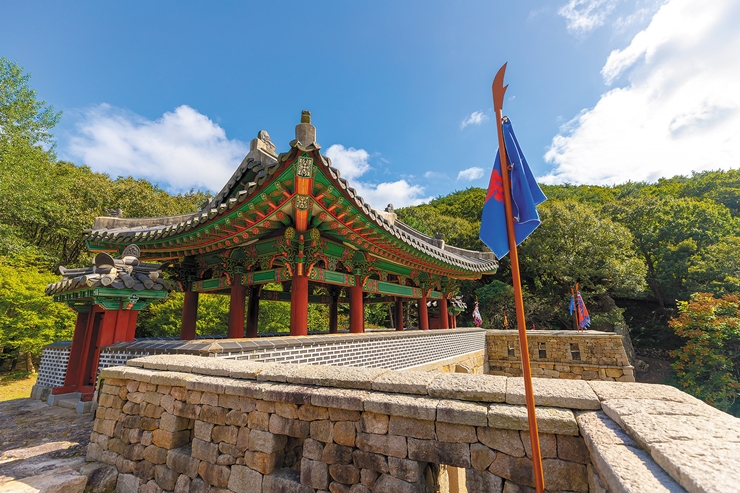욜로코스10서문_이민재(상단하늘합성).jpg&fileext=jpg&filetype=image/jpeg&filesize=381918) An inviting fortress atop Busan's tallest mountain
The YOLO Galmaetgil Trails invite visitors to experience scenic hikes along the city's natural and cultural resources. "YOLO" reflects both "you only live once" and the local dialect for "come here," blending global and regional meaning. Taken together, YOLO is an invitation for visitors to experience the joie de vivre locals have: Come to Busan and enjoy life.Geumjeongsanseong Fortress■ YOLO Route 10 Route 10, fondly known as "Picnic at Geumjeongsanseong Fortress," is a scenic 10-kilometer trail stretching from Gupo Station to Geumjeongsanseong Village. Geumbit Noeul Bridge The first highlight is Geumbit Noeul Bridge, where fiery skies dip over the Nakdonggang River. By day, it links bustling Gupo Market to tranquil Hwamyeong Eco Park; by night, colorful lights create a romantic backdrop for evening strolls.Hwamyeong Eco ParkThe glasshouse at Hwamyeong Arboretum Hwamyeong Eco Park shines in autumn, with rows of golden-brown metasequoias, and swaying silver grass. Nearby, Hwamyeong Arboretum - Busan's first public arboretum - displays themed gardens and seasonal wildflowers.Geumjeongsanseong Village The route continues to the western gate of Geumjeongsanseong Fortress, Korea's largest mountain stronghold, before ending at Geumjeongsanseong Village. Here, visitors savor local delicacies like black goat bulgogi and Sanseong Makgeolli.YOLO Guide : Click
An inviting fortress atop Busan's tallest mountain
The YOLO Galmaetgil Trails invite visitors to experience scenic hikes along the city's natural and cultural resources. "YOLO" reflects both "you only live once" and the local dialect for "come here," blending global and regional meaning. Taken together, YOLO is an invitation for visitors to experience the joie de vivre locals have: Come to Busan and enjoy life.Geumjeongsanseong Fortress■ YOLO Route 10 Route 10, fondly known as "Picnic at Geumjeongsanseong Fortress," is a scenic 10-kilometer trail stretching from Gupo Station to Geumjeongsanseong Village. Geumbit Noeul Bridge The first highlight is Geumbit Noeul Bridge, where fiery skies dip over the Nakdonggang River. By day, it links bustling Gupo Market to tranquil Hwamyeong Eco Park; by night, colorful lights create a romantic backdrop for evening strolls.Hwamyeong Eco ParkThe glasshouse at Hwamyeong Arboretum Hwamyeong Eco Park shines in autumn, with rows of golden-brown metasequoias, and swaying silver grass. Nearby, Hwamyeong Arboretum - Busan's first public arboretum - displays themed gardens and seasonal wildflowers.Geumjeongsanseong Village The route continues to the western gate of Geumjeongsanseong Fortress, Korea's largest mountain stronghold, before ending at Geumjeongsanseong Village. Here, visitors savor local delicacies like black goat bulgogi and Sanseong Makgeolli.YOLO Guide : Click
-
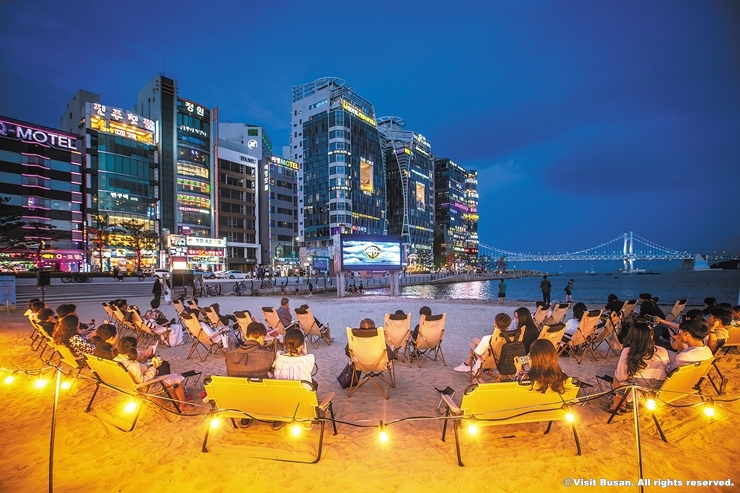.jpg&fileext=jpg&filetype=image/jpeg&filesize=337305) Lights! Coastline! Action!
Busan's YOLO Galmaetgil Trails invite visitors to enjoy life through scenic hikes along the city's natural and cultural resources. "YOLO" reflects both "you only live once" and the local dialect for "come here," blending global and regional meaning. Taken together, YOLO is an invitation for visitors to experience the joie de vivre locals have: Come to Busan and enjoy life.Grab a blanket and enjoy a free movie on Gwangan Beach.The iconic nightscape of Marine City.Fun photo opportunities await on Haeundae Cine Road.Movie screenings at Millak Ocean Cinema cost ₩3,000.Millak Waterside Park is a hot place to enjoy a cool evening.■ YOLO Route 4 Busan's YOLO Galmaetgil Route 4 offers trekkers a cinematic landscape befitting its "Centum Movie Night" nickname. Stretching 4.5 kilometers along the coast, the trail is best enjoyed at night when the city, sea and sky create the perfect mise-en-scene. The plot begins at The Bay 101, where Marine City's skyscrapers glow in mirrored reflections on the water to create an iconic nightscape. From there, the path leads to Haeundae Cine Road, an open-air gallery celebrating Korean cinema with film-inspired art and photographs. Continuing past the Suyeongman Bay Yachting Center, walkers arrive at Millak Waterside Park, a popular spot to relax and view the Gwangandaegyo Bridge. Here, Millak Ocean Cinema stages outdoor movie screenings on weekends, with a floating screen set against the bridge's dazzling backdrop. Nearby, Gwangalli Beach Cinema offers free Friday night films by the sea.Learn more : Click
Lights! Coastline! Action!
Busan's YOLO Galmaetgil Trails invite visitors to enjoy life through scenic hikes along the city's natural and cultural resources. "YOLO" reflects both "you only live once" and the local dialect for "come here," blending global and regional meaning. Taken together, YOLO is an invitation for visitors to experience the joie de vivre locals have: Come to Busan and enjoy life.Grab a blanket and enjoy a free movie on Gwangan Beach.The iconic nightscape of Marine City.Fun photo opportunities await on Haeundae Cine Road.Movie screenings at Millak Ocean Cinema cost ₩3,000.Millak Waterside Park is a hot place to enjoy a cool evening.■ YOLO Route 4 Busan's YOLO Galmaetgil Route 4 offers trekkers a cinematic landscape befitting its "Centum Movie Night" nickname. Stretching 4.5 kilometers along the coast, the trail is best enjoyed at night when the city, sea and sky create the perfect mise-en-scene. The plot begins at The Bay 101, where Marine City's skyscrapers glow in mirrored reflections on the water to create an iconic nightscape. From there, the path leads to Haeundae Cine Road, an open-air gallery celebrating Korean cinema with film-inspired art and photographs. Continuing past the Suyeongman Bay Yachting Center, walkers arrive at Millak Waterside Park, a popular spot to relax and view the Gwangandaegyo Bridge. Here, Millak Ocean Cinema stages outdoor movie screenings on weekends, with a floating screen set against the bridge's dazzling backdrop. Nearby, Gwangalli Beach Cinema offers free Friday night films by the sea.Learn more : Click
-
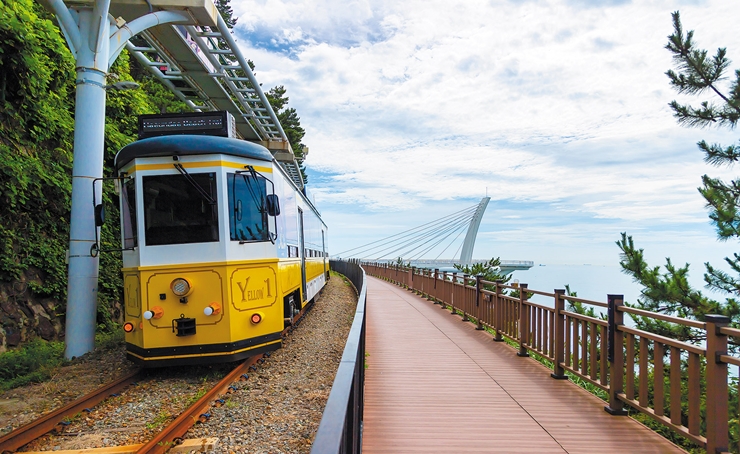 Seaside serenity on the Blue Line
Busan's YOLO Galmaetgil Trails are beloved hiking routes that showcase the city's natural resources and cultural offerings. YOLO has two sources of inspiration. First, from "you only live once," the acronym that describes the mindset that life should be enjoyed; second, from the phrase "come here" as pronounced in the local dialect. Taken together, YOLO invites visitors to experience the joie de vivre locals have: Come to Busan and enjoy life.A retro train, lush forest and ocean views can be found on YOLO Galmaetgil Route 3.Songjeong Beach is the birthplace of Korea's surf culture.A wooden deck runs along Busan돴s eastern coast, side-by-side with trains from the Haeundae Blue Line.Haewol Observatory.Cheongsapo Daritdol Observatory.■ YOLO Route 3 For a refreshing seaside stroll with sweeping ocean views, YOLO Galmaetgil Route 3 offers one of Busan's most picturesque escapes. This scenic 5.8-kilometer route stretches from Songjeong Station to Mipo Station, hugging the city's eastern coastline. A 10-minute walk from Songjeong Station leads to Songjeong Beach. This sandy playground is a favorite year-round, but it buzzes in August with sunseekers and surfers alike. From the beach, trekkers follow a wooden deck that winds along the coast. With brilliant blue water on one side and lush greenery on the other, it's easy to appreciate this urban paradise. Midway through, take a breather at the Cheongsapo Daritdol or Haewol observatories. Their reinforced glass floors offer a heart-pounding view of the waves crashing below. With the sea swirling beneath your feet, either place offers a memorable spot to take a picture and rest before finishing the trail.YOLO Guide : Click
Seaside serenity on the Blue Line
Busan's YOLO Galmaetgil Trails are beloved hiking routes that showcase the city's natural resources and cultural offerings. YOLO has two sources of inspiration. First, from "you only live once," the acronym that describes the mindset that life should be enjoyed; second, from the phrase "come here" as pronounced in the local dialect. Taken together, YOLO invites visitors to experience the joie de vivre locals have: Come to Busan and enjoy life.A retro train, lush forest and ocean views can be found on YOLO Galmaetgil Route 3.Songjeong Beach is the birthplace of Korea's surf culture.A wooden deck runs along Busan돴s eastern coast, side-by-side with trains from the Haeundae Blue Line.Haewol Observatory.Cheongsapo Daritdol Observatory.■ YOLO Route 3 For a refreshing seaside stroll with sweeping ocean views, YOLO Galmaetgil Route 3 offers one of Busan's most picturesque escapes. This scenic 5.8-kilometer route stretches from Songjeong Station to Mipo Station, hugging the city's eastern coastline. A 10-minute walk from Songjeong Station leads to Songjeong Beach. This sandy playground is a favorite year-round, but it buzzes in August with sunseekers and surfers alike. From the beach, trekkers follow a wooden deck that winds along the coast. With brilliant blue water on one side and lush greenery on the other, it's easy to appreciate this urban paradise. Midway through, take a breather at the Cheongsapo Daritdol or Haewol observatories. Their reinforced glass floors offer a heart-pounding view of the waves crashing below. With the sea swirling beneath your feet, either place offers a memorable spot to take a picture and rest before finishing the trail.YOLO Guide : Click



![[K-Words You Need to Know] Nae mah-lee (내 말이) thumbnail](/ImagePrint.do?dir=smartEditor&savename=759abc759d294cfebfb30d6c1ca530fe&realname=nn-001.jpg&fileext=jpg&filetype=image/jpeg&filesize=58643)




